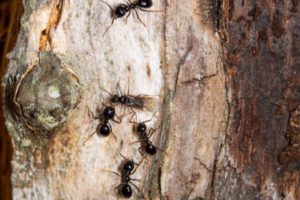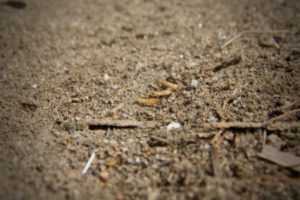TELLING THE DIFFERENCE BETWEEN CARPENTER ANT AND TERMITE DAMAGE
By Zachary Ciras on October 19, 2020.
Two of the main wood-damaging insects in our region are active right now: carpenter ants and subterranean termites. Most homeowners can probably point to a section of damaged wood in their home but the question might remain, which pest caused the damage? And what needs to be done about it?
 If the wood is damp or the area has had water damage in the past, the list can usually be narrowed down to wood rot, or carpenter ants, or subterranean termites. All of these wood pests prefer wood that has been softened by high wood moisture levels.
If the wood is damp or the area has had water damage in the past, the list can usually be narrowed down to wood rot, or carpenter ants, or subterranean termites. All of these wood pests prefer wood that has been softened by high wood moisture levels.
Wood decay can usually be ruled out, or ruled in, pretty easily due to certain characteristics of the fungi that cause the rot. Carpenter ant and termite damage are not always as easy to tell apart, especially without breaking into the wood. Insects that are feeding or tunneling inside a piece of wood in a structure rarely betray their presence on the wood exterior. A piece of baseboard or other wood, even if painted, may look normal, maybe showing only a slight blistering on the surface.
1. If you probe into or break open a section of insect-damaged wood:
An important tip is that termites actually feed on and ingest the wood, leaving behind some fecal evidence that is a muddy slurry of digested wood, saliva, and soil layered into the wood. Carpenter ants, on the other hand, do not feed on the wood but they do tunnel in the wood, hollowing out smooth galleries for nest sites. Their food, as for most ants, is dead or dying insects, seeds, and maybe people food.
In most cases, our eastern termites nest outside in the ground and travel to their wood food site through soil or mud tubes that they have constructed. Termites tend to eat the softer layers of the wood, leaving the harder wood and a honeycomb appearance. Dried “mud” inside the damaged area is an indicator of termites but it is not always obvious. If you break into a piece of wood that still has termites present, you may see worker termites running away and soldier termites with large mandibles running toward the intruder (you).
Where termite-damaged wood may look messy, carpenter ant-damaged wood has smooth, clean galleries without any wood particles or soil. Carpenter ants begin their galleries in softer springwood, later creating wider galleries that may contain ant eggs or larvae. The ants dump the sawdust, dead insects, seed coats, fecal pellets, and any other debris out of the galleries through slits in the wood.
2. If you find live (or even dead) insects:
If you find ants or termites along with the damage, that makes identification easier, but since both carpenter ants and subterranean termites like the same conditions and locations, you can sometimes find both causing damage in the same area.

Group of termites near recently exposed damage. Z. Ciras
Color (whitish termites vs. dark ants), body shape (ants have a “waist,” termites don’t) and antennae (termite antennae are straight, ants’ are elbowed) are just some of the clues to differentiate worker ants from worker termites.
If you happen to be dealing with the reproductive or winged form of either insect, it becomes more difficult. Winged forms of both carpenter ants and subterranean termites are dark in color and have two pairs of wings. All four of the termite’s wings are the same size, while in ants the forward pair of wings is larger. If you see dark termites, they are likely reproductives that have shed their wings, a normal occurrence during swarming.
3. If you need a professional inspection and identification:
Even if you think you know what caused your wood damage, there could be a penalty for error if you attempt to control the wrong pest since finding and destroying the insects’ nest is important.
Fortunately, the trained technicians at Colonial Pest can identify both carpenter ants and termites and their damage. They can tell you whether the damage is old and the pests long gone, or whether you have an ongoing infestation that requires control. Our technician can explain your control options and Colonial Pest Control’s COVID-19 Response precautions.
For more information on carpenter ant and termite damage, see these Colonial Pest blogs and info sheets: